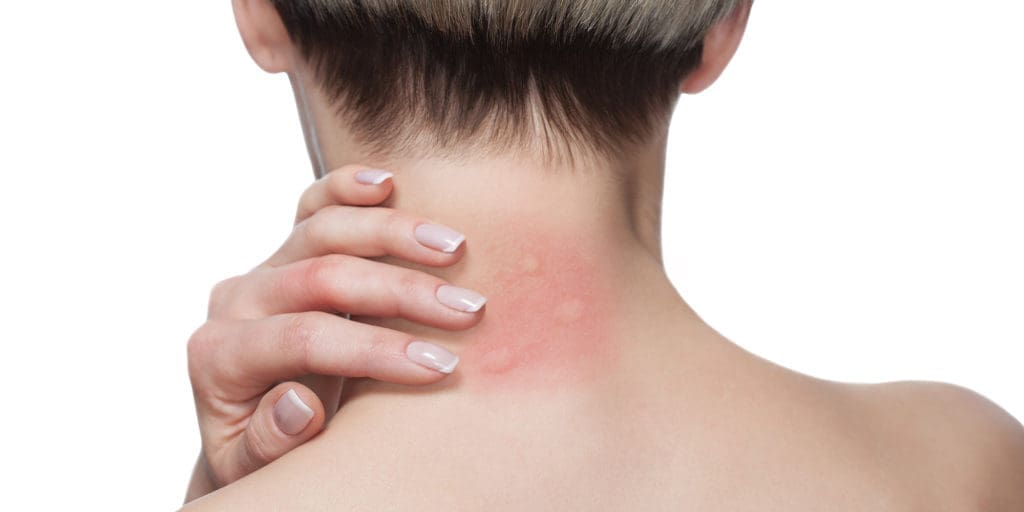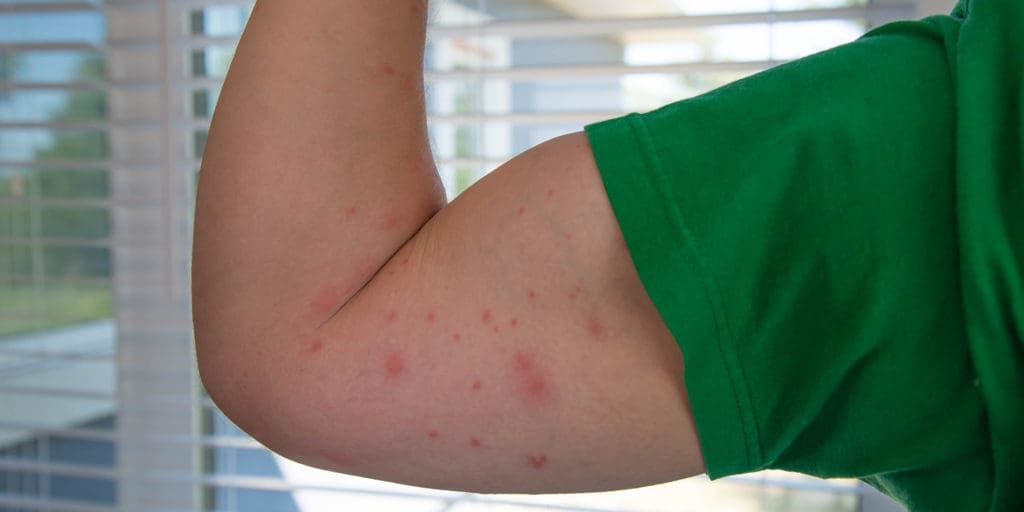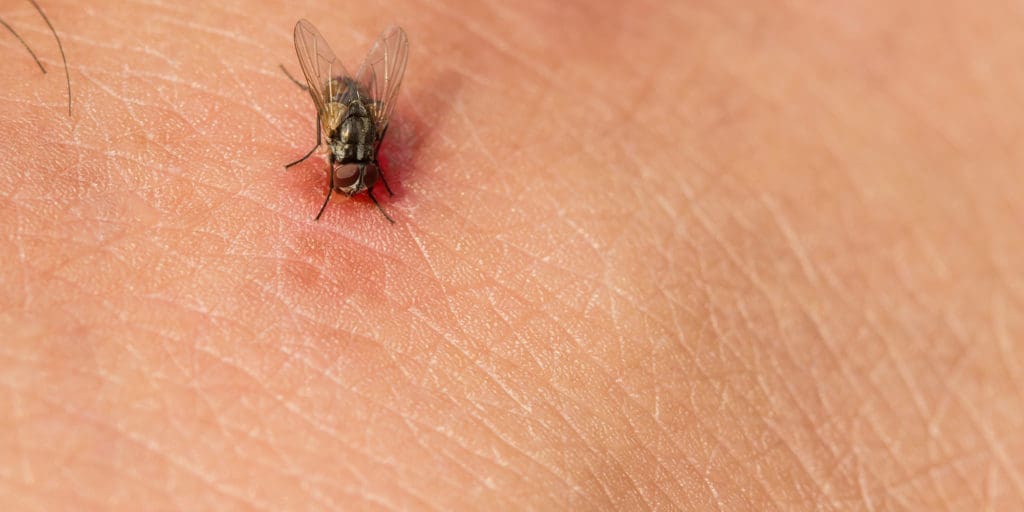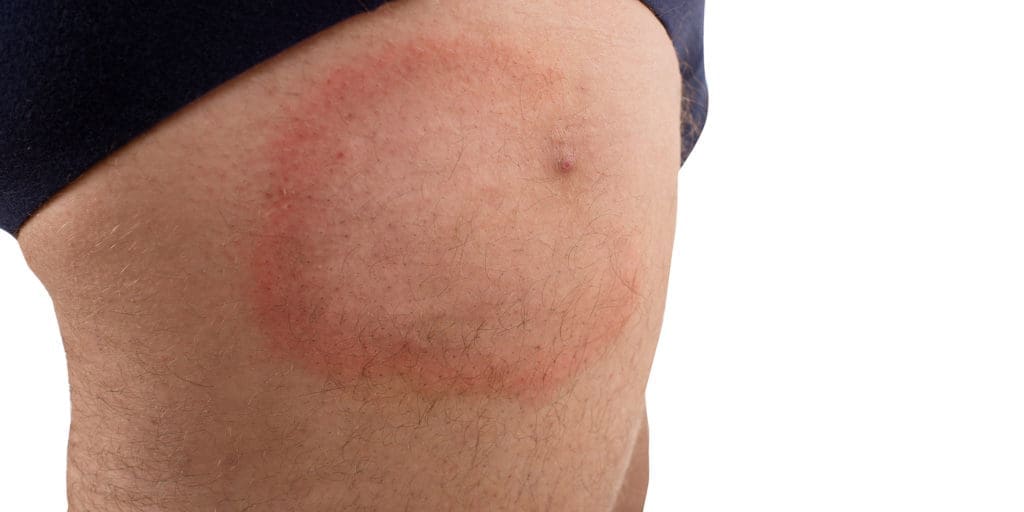Summertime is almost upon us, and with the warming weather and vaccination levels continuing to rise, more and more people are looking forward to spending time outdoors. Enjoying outdoor activities can be great, but can also come with the unintended consequence of bug bites.
Bug bites can occur anywhere on the body, and unless you see them happen, it can be difficult to determine what kind of bug may have bit you. Thankfully, we’ve got you covered. Below are 10 of the most common types of bug bites, along with how to identify and treat them.
Bee Stings Can Cause Allergic Reactions
 Bee stings are an all too common outdoor occurrence, and in most cases don’t require any special treatment besides at-home care. However, for those that are allergic, or for those that may find themselves stung multiple times, more serious, and sometimes even life-threatening, reactions can occur.
Bee stings are an all too common outdoor occurrence, and in most cases don’t require any special treatment besides at-home care. However, for those that are allergic, or for those that may find themselves stung multiple times, more serious, and sometimes even life-threatening, reactions can occur.
There are several different types of bees, or bee-like insects, that sting. These include wasps, yellow jackets and hornets, honey bees, Africanized honey bees, and bumblebees. Except for wasps, all of the previously mentioned insects can typically only sting once, and will typically die within minutes after stinging someone.
Why do bees sting? It’s quite simple, bees, especially honey bees, sting when they feel threatened. Honey bees can live in colonies up to 80,000 strong, and will all have the same instinct to protect themselves and their home. By respecting their space and taking some additional precautions when around bees, stings can be very easy to avoid.
Bee Sting Symptoms
Bee stings can differ from many other common bug bites in a few ways. The first way to identify a bee sting is by looking to see if the bee’s stinger is stuck in the skin. Except for wasp stings, bees will almost always leave their stinger behind after they sting you. This is because a bee’s stinger is barbed, which makes it difficult to pull out.
Reactions to bee stings can range from mild to severe, and it’s important to understand the differences between when at-home care is sufficient and when you may need to go to the hospital.
Bee stings, regardless of the level of reactions, will cause a sharp, intense stinging sensation that will typically last for a few minutes. Most mild reactions will then gradually lessen to a slight achiness of the affected area. The skin will usually have a red bump where the stinger was, and can oftentimes feel hot to the touch or even itchy.
For more moderate and severe reactions, the sting site will become extremely red and swollen over the following 1-2 days. Moderate reactions tend to dissipate within 10 days, and symptoms will not typically progress past this point.
Severe allergic reactions to bee stings (anaphylaxis) can be life-threatening and always require emergency medical attention. Severe anaphylaxis is very uncommon, affecting just 3% of the population, but signs of a severe allergic reaction are thankfully easy to spot. Someone who is experiencing anaphylaxis can experience any of the following symptoms:
- Swelling of the throat and tongue
- Loss of consciousness
- A weak or rapid pulse
- Nausea, vomiting, or diarrhea
- Dizziness or fainting
- Hives or itchy skin
- Difficulty breathing
For severe reactions to bee stings, or if you notice any of the above symptoms, seek emergency medical attention immediately.
How to Treat Bee Stings
Bee stings are often relatively easy to treat, and will generally not require any care above what you can administer at home. For those mild to moderate cases of bee stings, remove the stinger, if you can, as soon as possible using your fingernails to scrape over the area. Do not use tweezers, as doing so could drive the stinger further under the skin.
Wash the affected area with soap and water, and apply a cold compress. You may take an over-the-counter medication such as acetaminophen or ibuprofen as needed to help with pain and discomfort.
For more moderate cases of bee stings, elevating the sting to reduce blood flow to the area can help. Hydrocortisone creams and oral antihistamines that contain diphenhydramine (Benadryl) can also help with itching and swelling in those more moderate stings.
Can a Mosquito Bite Cause Serious Illness?


Mosquitos live in grassy or bushy areas close to standing water such as pools and ponds, or any other water source that isn’t flowing. When a mosquito bites you, it pierces your skin using a specialized part of its mouth, known as a proboscis, to suck up blood. When it does this, it also injects saliva into your skin, which is what causes the itching sensation famously associated with mosquito bites.
Along with their pesky itching, mosquitos can also carry deadly diseases such as Zika virus, West Nile virus, malaria, or eastern equine encephalitis (EEE). Malaria and Zika virus are extremely rare in the United States but remain a very real threat in other parts of the world, namely Africa where nearly 200 million cases of malaria are diagnosed every year.
What Does a Mosquito Bite Look Like?
Mosquito bites are annoying. When a mosquito bites you, you may feel a slight stinging sensation, followed almost immediately by an itching sensation. Once a mosquito bites, you may notice a small round bump on the skin. Most bumps are only about a half-inch in diameter and will become swollen and hard to the touch.
People with compromised immune systems, as well as children, will typically have a stronger reaction to mosquito bites than the average person. For the average person, a mosquito bite will typically itch for about 3-4 days.
How to Treat Mosquito Bites
For most all mosquito bites, simple, at-home remedies are enough to curb symptoms. Start by washing the area with soap and warm water. You can use over-the-counter products such as anti-itch medications or pain relievers to help with itch-related symptoms. Ice packs and cold compresses can also help reduce itching and swelling.
While mosquito-borne illnesses may be rare, they are not uncommon, and allergic reactions to mosquito bites have also been documented, however they are a rare occurrence. If you develop any symptoms outside of the normal itching and minor swelling of the bite, it may be time to contact your doctor. Those symptoms can include body aches, headaches, fever after being bitten, or bites that itch and persist for longer than a week.
Can I Get Fleas From My Pets?


Despite this lack of wings, fleas are renowned for their ability to leap large distances, in some instances leaping up to 13 inches, which is nearly 200 times their body length. Fleas feed on blood and can consume large amounts of the stuff, often drinking up to 15 times their body weight.
While the threat of contracting a disease from flea bites is rare, bacteria carried by the tiny insects can get into your bloodstream and cause infection, which is why being able to spot fleas before they become a problem is extremely important.
How to Spot Fleas
If you have pets, you are probably no stranger to fleas. Thankfully, fleas prefer to live on pets, as they are hosts with thick, protective fur, and can’t scratch them off as easily as humans do. However, a bad flea infestation can find its way from little Milo to you, and that can be extremely unpleasant.
For the most part, symptoms from a flea bite will begin within hours after you’ve been bitten. Flea bites will result in a fairly severe itching sensation, and the skin around the bite may become sore. Spotting fleas can be difficult, but their bites can often be very distinctive, which can help determine whether or not you have fleas.
Flea bites will be small, red bumps on the skin that appear in clusters because where there’s one flea there’s more. Unlike other insect bites, like mosquitos, the bite will remain the same size no matter how much you itch. The bites will most likely be around the legs and ankles, as well as the armpits, groin, or around the elbows and knees.
How to Treat Flea Bites
Do. Not. Itch. Flea bites can be extremely uncomfortable and can cause a terrible itching sensation. Although it may be difficult to resist, itching flea bites can further the damage to the skin, and in some cases can even cause bacterial infections of the affected area.
Flea bites themselves will subside with time, however, getting rid of fleas is the only way to effectively treat fleas. For flea bites, over-the-counter anti-itch creams and antihistamines can help curb itch-related symptoms and discomfort.
For most cases of fleas that spread to humans, thorough, deep cleaning of the home is likely the best option. Once fleas have spread to humans, they are likely spread throughout the home, and in most instances, pesticides may be the only viable option to truly eradicate the infestation.
Some Types of Flies Can Cause Painful Bites


Horse flies and deer flies, unlike other flies and mosquitos, both bite with scissor-like mouthparts, which cut into the skin causing blood flow. This method of biting, which is typically meant for animals with very thick skin, means that if they bite you, it can be extremely painful.
Although extremely rare, there have been documented cases of allergic reactions to horsefly and deer fly bites. However, the more prominent risk is an infection due to the nature of how the insect bites. Horsefly and deer fly bites can be slow to heal, and means they leave the body open to infection if not treated properly.
Fly Bite Symptoms and Treatments
Horsefly and deer fly bites can be very painful. The bite itself will be a sharp, painful stinging sensation, which will typically form into a swollen, red bump on the skin. The bite area will generally draw blood due to the method in which these flies bite, and can take up to a week to heal.
Aside from the momentary pain, horse flies and deer flies pose no real threat to humans. Once bitten, treat the area like any minor cut or scrape. Cleanse the bite with soap and water, and cover with a bandage if blood has been drawn. Over-the-counter antiseptic ointments can also help reduce the chances of infection.
If you notice that your horse fly or deer fly bite hasn’t healed in over a week, or if you notice possible signs of infection, contact your doctor to figure out what your next steps should be.
Do I Have Bed Bugs?


How to Identify Bed Bug Bites
Since bed bugs typically bite at night, their bites often go unnoticed at first. What most people will experience, however, is a cluster of raised red marks on the body, oftentimes forming a line. Bed bug bites can occur anywhere on the body, but will most often occur on exposed areas of the body such as the back, neck, and legs.
In most cases of bed bug bites, the bite will produce mild to moderate pain, discomfort, and itchiness after waking. Some common symptoms of bed bug bites can include any of the following:
- Burning or painful sensation around the affected area
- A raised, itchy bump with a clear center
- Small spots of dried blood on sheets or clothing from bites
- White or clear skins, which are shed by bed bug larva as they mature
- Small red bumps surrounding the bite
- Hives or blisters
How to Treat Bed Bug Bites
Bed bug bites should be treated like any other insect bite. Start by washing the affected area with soap and water, followed by over-the-counter medications such as hydrocortisone or acetaminophen to help with pain and itching.
For most all cases of bed bugs, wounds will typically heal on their own. If symptoms persist for more than a week or two, or if you notice severe swelling or inflammation, contact your doctor to find out if you may have an allergic reaction to bed bugs.
Do All Ticks Carry Lyme Disease?


Ticks are small parasitic insects that feed on the blood of animals such as deer, raccoons, opossums, squirrels, and yes; humans. They live in tall, grassy woodland environments where they can easily move from host to host; which makes them extremely efficient disease spreaders.
For the most part, tick bites are harmless and are not carriers of disease. Some estimates put the chance of a tick carrying diseases such as Lyme disease anywhere from 0-50%, and although it may seem high, the percentage depends heavily on what kind of tick you have been bitten by, where it came from, and how long it has been attached.
According to the Centers for Disease Control and Prevention (CDC), a tick needs to feed for at least 36 hours for the Lyme disease bacteria to be transmitted to the host. An easy way to significantly lower your chances of contracting a disease from a tick bite is to thoroughly check your body after spending time outdoors, especially after spending time in thick or tall grass.
There are only two species of ticks that are known to carry Lyme disease; those being the blacklegged tick (deer tick or Ixodes scapularis), and the western blacklegged tick (Ixodes pacificus). These two ticks are found primarily in the northeast and western United States respectively. This means that your chances of contracting Lyme disease from a tick are significantly less if you live in the southern or central United States.
Symptoms and Treatments for Tick Bites
Tick bites are virtually painless themselves, and will almost always go unnoticed. This makes ticks especially dangerous, as they are hard to detect without looking for them. Tick bites alone do not cause any symptoms. Most tick-borne illnesses, however, have symptoms that closely mimic each other; the most common of which is Lyme disease.
Some symptoms of these illnesses can include some of the following:
- In cases of Lyme disease, a circular, “bullseye” pattern rash will appear within 3-30 days, followed by a fever
- Muscle fatigue
- Headaches
- Joint pain
- Swollen or painful joints
- Memory loss
Tick bites on their own do not require much treatment. The most important part is finding and removing the tick. Using a tick removal tool or a pair of tweezers, grasp the tick as close to the skin as possible, and gently pull until removed. If you notice any debris or mouthparts from the tick in the bite, remove those as well. Next, wash the affected area with soap and water, and ensure the tick is dead by submerging it in rubbing alcohol.
If you notice any of the above-listed symptoms, or if the bite area becomes infected, contact your doctor immediately.
What Spider Bites are Dangerous?


The majority of spiders in the world are not venomous. In fact, of the nearly 3,000 known species of spiders in the United States, only three are venomous. These spiders include the brown recluse, the black widow, and the hobo spider. While there are other species of spiders in the United States that carry toxins, the aforementioned three are the only ones capable of delivering a lethal bite.
Spiders typically live in dark, uninhabited areas, but can sometimes make their way into the home, where they can pose a serious threat. For some, a small sting may accompany the bite, followed by a sharp pain in the affected area. Others may not realize they’ve been bitten until hours later when symptoms begin to arise.
How to Identify and Treat a Spider Bite
Symptoms of spider bites can vary depending on the species, which can help identify the spider when seeking medical attention.
Brown recluse bites usually go unnoticed, meaning you may not realize you’ve been bitten. If you don’t see the spider bite you, it’s important to pay attention to your symptoms to avoid serious health complications or even death. Brown recluses rarely bite with enough venom to kill, however, if you suspect you’ve been bitten by one you should seek medical attention immediately.
Symptoms of a brown recluse bite can include:
- Fever
- Nausea
- Chills
- Sweating
- Intense itching or rash at the site of the bite
- A unique deep purple or blue discoloration around the bite between 12-36 hours after being bitten
The black widow spider is another extremely venomous spider that can cause severe health conditions or death in rare circumstances. Symptoms of a black widow bite can closely mimic that of a hobo or brown recluse, however, the initial bite is much more painful, and rarely goes unnoticed.
A black widow spider bite will cause pain immediately, followed by redness, burning, and swelling at the site of the bite. Other symptoms that may follow a black widow spider bite can include:
- Headache
- Severe high blood pressure
- Chills
- Fever
- Nausea, diarrhea, or vomiting
- Muscle cramps and spasms that increase in severity
- Severe back, chest, or belly pain
For any spider bite, especially those that you think may be venomous, you must seek medical attention immediately. If you can do so safely, bring the spider with you to the doctor so that they can determine whether or not you need antibody treatment.
What Types of Bug Bites Would You Like to Know More About?
Ask away in the comments section below!
What Topics About Bug Bites Should We Cover Next?
Email us at info@painresource.com with your ideas.
Are you on Facebook?




